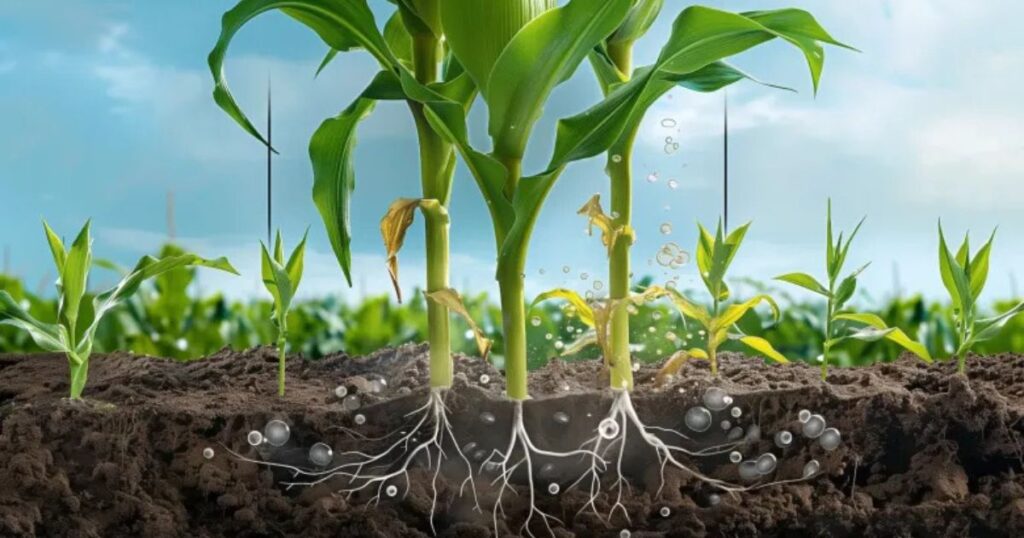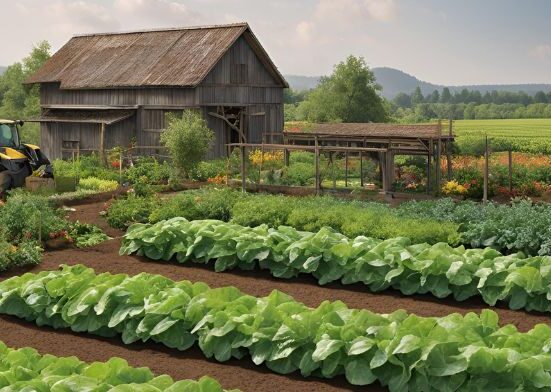Soil is the foundation of life on Earth. It provides essential nutrients for plant growth, filters water, stores carbon, and hosts diverse organisms. However, years of industrial agriculture, deforestation, and overgrazing have led to widespread soil degradation. To combat this and ensure food security for future generations, there is an urgent need to adopt sustainable practices that preserve and enhance soil fertility. This blog explores organic methods contributing to healthier soils, increased agricultural productivity, and environmental sustainability.
Importance of Soil Health in Agriculture and Ecosystems
Soil health is fundamental to sustainable agriculture and the stability of ecosystems. Rich in organic content, brimming with beneficial organisms, and able to hold onto water and nutrients, healthy soil creates the perfect environment for plant growth. In agriculture, maintaining soil health increases crop yields, enhances resistance to pests and diseases, and reduces the need for chemical fertilizers and pesticides. Beyond farming, healthy soil supports biodiversity, regulates the water cycle, and acts as a carbon sink, helping to mitigate climate change.
Degraded soil, on the other hand, leads to erosion, reduced fertility, and loss of productivity, threatening food security and ecosystem resilience. Practices like crop rotation, reduced tillage, cover cropping, and organic amendments are crucial in preserving soil vitality. Investing in soil health is necessary for agricultural success and vital in ensuring long-term ecological balance and environmental Weed management strategies sustainability.
Soil Fertility
Soil fertility refers to the soil’s ability to sustain plant growth and optimize crop yield. It encompasses the soil’s physical, chemical, and biological characteristics that support healthy plant development. A fertile soil ways to improve soil fertility and productivity provides essential Organic methods to enhance soil fertility nutrients, has a suitable root development and water retention structure, and harbors beneficial microbial methods to increase soil fertility.
Definition and Key Components of Fertile Soil
A fertile soil supplies adequate nutrients, supports biological activity, and maintains a favorable physical structure. The key components include:
- Nutrients: Essential elements like nitrogen (N), phosphorus (P), potassium (K), calcium (Ca), magnesium (Mg), and micronutrients are required for plant growth.
- Structure: Good soil structure promotes proper aeration, water infiltration, and root penetration. It usually features well-aggregated particles and balanced pore space.
- Biology: A diverse and active community of soil organisms, including bacteria, fungi, earthworms, and insects, contributes to nutrient cycling, organic matter decomposition, and disease suppression.
Role of Organic Matter in Fertility
Organic matter is critical to maintaining soil fertility. It improves soil structure, enhances moisture retention, and serves as a nutrient reservoir. As it decomposes, organic matter releases nutrients in a form plants can use and fuels microbial activity that further supports plant health. Additionally, it helps buffer pH and can reduce the need for synthetic methods to maintain soil fertility inputs.
Principles of Organic Soil Management
 Principles of Organic Soil Management focus on building and maintaining healthy, living soil to support sustainable agriculture. Key practices include enhancing soil organic matter through composting, green manures, and cover crops, fostering biodiversity, and minimizing soil disturbance. Nutrient cycling is promoted naturally, relying on microbial activity rather than synthetic fertilizers. Pest and disease control is achieved through balanced ecosystems rather than chemical interventions. Organic soil management emphasizes long-term soil fertility, water conservation, and climate resilience. Nurturing the soil’s natural processes ensures productive, eco-friendly farming while protecting environmental and human health. These principles form the foundation of regenerative agriculture.
Principles of Organic Soil Management focus on building and maintaining healthy, living soil to support sustainable agriculture. Key practices include enhancing soil organic matter through composting, green manures, and cover crops, fostering biodiversity, and minimizing soil disturbance. Nutrient cycling is promoted naturally, relying on microbial activity rather than synthetic fertilizers. Pest and disease control is achieved through balanced ecosystems rather than chemical interventions. Organic soil management emphasizes long-term soil fertility, water conservation, and climate resilience. Nurturing the soil’s natural processes ensures productive, eco-friendly farming while protecting environmental and human health. These principles form the foundation of regenerative agriculture.
Building Soil Rather Than Feeding Plants
This principle emphasizes nurturing the soil instead of directly feeding the plants with synthetic fertilizers. Plants can naturally access the necessary nutrients by improving soil structure, organic matter content, and microbial life. Healthy, living soil is the foundation for sustainable and resilient plants what are some ways to improve soil fertility growth?
Enhancing Natural Biological Activity
Organic soil management promotes the activity of beneficial soil organisms such as earthworms, fungi, and bacteria. These organisms play a vital role in breaking down organic matter, cycling nutrients, improving soil structure, and supporting plant health. Encouraging biological diversity helps maintain a self-regulating, fertile soil ecosystem.
Recycling Nutrients and Minimizing External Inputs
This principle closes the nutrient loop by returning organic materials—like compost, crop residues, and green manures—to the soil. Organic systems and organic fertilizer maintain long-term fertility, minimize environmental impact, and support local sustainability by recycling nutrients on-site and reducing reliance on outside inputs.
The Importance of Organic Soil Management
Organic soil management is essential for maintaining healthy, productive, and sustainable agricultural systems. By using natural methods such as composting, cover cropping, and crop rotation, organic soil management enhances soil structure, fertility, and biodiversity. It stays away from artificial pesticides and fertilizers, which can degrade soil health over time and harm beneficial organisms. Instead, organic practices promote the growth of microorganisms and earthworms, contributing to nutrient cycling and improved soil aeration. Healthy soil is better able to retain water, resist erosion, and support resilient crops, making it vital in the face of climate change.
Additionally, organic soil management reduces environmental pollution and greenhouse gas emissions, supporting cleaner air and water. These methods can lead to long-term cost savings and increased productivity for farmers and gardeners. Overall, organic soil management is a key component of regenerative agriculture and is crucial in ensuring food security and environmental sustainability.
Organic Methods to Enhance Soil Fertility
 Organic methods to enhance soil fertility focus on natural processes to improve soil health, productivity, and sustainability. One key approach is composting, where organic waste like kitchen scraps and garden trimmings are decomposed to create nutrient-rich compost, enriching the soil with essential elements. Green manures, such as clover or alfalfa, are planted to fix nitrogen and improve soil structure when incorporated into the soil. Crop rotation is another effective method, preventing nutrient depletion and reducing pest buildup by alternating crops with different nutrient needs.
Organic methods to enhance soil fertility focus on natural processes to improve soil health, productivity, and sustainability. One key approach is composting, where organic waste like kitchen scraps and garden trimmings are decomposed to create nutrient-rich compost, enriching the soil with essential elements. Green manures, such as clover or alfalfa, are planted to fix nitrogen and improve soil structure when incorporated into the soil. Crop rotation is another effective method, preventing nutrient depletion and reducing pest buildup by alternating crops with different nutrient needs.
Mulching helps conserve moisture, suppress weeds, and enhance organic matter content. Additionally, using organic fertilizers like bone meal, fish emulsion, and manure provides a slow-release source of nutrients. These methods, when combined, foster a healthier, more resilient soil ecosystem that promotes sustainable farming practices, reduces dependence on synthetic inputs, and supports long-term agricultural productivity.
Composting
Compost is decomposed organic material rich in nutrients. Adding compost to soil increases organic matter, improves texture, and introduces beneficial microbes. These are crops grown primarily to be incorporated back into the soil. Leguminous cover crops (e.g., clover, vetch) fix atmospheric nitrogen, methods used to apply organic and inorganic fertilizers enriching the How to improve soil health in home gardens soil.
Benefits:
- Prevent soil erosion.
- Suppress weeds.
- Add organic matter and nutrients.
Crop Rotation and Polyculture
Rotating crops and planting multiple species prevent nutrient depletion and break pest and disease cycles. Properly composted manure adds organic matter and nutrients, such Organic methods to enhance soil fertility as
Mulching
Applying organic mulch (e.g., straw, wood chips, leaves) on the soil surface conserves moisture, regulates temperature, and gradually enriches the soil as it decomposes.
Vermicomposting
This method uses worms to decompose organic waste, producing nutrient-rich worm castings.
Benefits:
- Enhances microbial activity.
- Improves soil structure.
- Increases nutrient availability.
Soil Testing and Monitoring
Soil testing and monitoring are essential agricultural, construction, and environmental management practices. Analyzing soil samples to ascertain their composition is known as soil testing. pH level, nutrient content, and other properties influencing plant growth, crop yield, and ecosystem health. Farmers and gardeners can identify deficiencies or imbalances in the soil by conducting soil tests and making informed decisions about fertilizers and soil amendments. Monitoring involves regularly checking soil conditions to track changes, such as moisture levels, temperature, and organic matter content.
This continuous observation helps prevent problems like soil degradation or erosion and ensures sustainable land use. Advanced technologies, such as sensors and remote sensing, are increasingly used for real-time soil monitoring, providing more accurate and timely data. Together, soil testing and monitoring are crucial for optimizing agricultural productivity, conserving natural resources, and
Encouraging Soil Biodiversity

Encouraging soil biodiversity is essential for maintaining healthy ecosystems and sustainable agriculture. A diverse soil community of microorganisms, fungi, earthworms, and other organisms plays a crucial role in nutrient cycling, soil structure, and pest regulation. Enhancing soil health through biodiversity promotion results in higher crop yields, less dependency on chemical fertilizers, and increased resistance to pests and diseases. Resilience to pests and diseases. Practices such as reducing chemical pesticide use, increasing organic matter through composting, rotating crops, and planting cover crops can foster a thriving soil ecosystem.
Additionally, minimizing soil disturbance, such as no-till farming, helps protect the delicate balance of organisms. Encouraging soil biodiversity enhances agricultural productivity and contributes to carbon sequestration, mitigating climate change. Overall, supporting soil biodiversity is a key strategy for sustainable land management, ensuring that the land remains productive and resilient for future Flood Irrigation Pros and Cons generations.
Organic Fertilizers and Soil Amendments
Organic fertilizers and soil amendments are natural substances that improve soil fertility, structure, and health. These fertilizers break down slowly, releasing nutrients over time, which helps reduce the risk of nutrient leaching and promotes long-term soil health. Common organic fertilizers include compost, manure, and bone meal.
On the other hand, soil amendments are materials added to soil to improve its physical properties, such as drainage, aeration, and moisture retention. Organic amendments like compost, mulch, and peat moss enhance soil texture and foster beneficial microorganisms. Organic fertilizers and amendments create a balanced, sustainable growing environment, improving plant growth while reducing the need for synthetic chemicals. These eco-friendly natural options promote a healthier, more resilient ecosystem for plants and soil.
Challenges and Considerations
Challenges and considerations refer to the obstacles and factors that must be considered when undertaking any task or project. These include potential risks, limitations, and uncertainties that could affect outcomes. Challenges may arise from resource constraints, technical difficulties, lack of expertise, or unforeseen external factors. Conversely, considerations involve balancing competing priorities, such as cost versus quality, speed versus accuracy, or short-term goals versus long-term sustainability. Additionally, ethical concerns, stakeholder expectations, and regulatory requirements may complicate decision-making processes.
Recognizing and addressing these challenges and considerations early on can lead to better planning, risk mitigation, and improved problem-solving strategies, ultimately enhancing the chances of success. Being proactive and adaptable in overcoming challenges and carefully considering all variables is essential for achieving desired results.
Transition Period from Conventional to Organic
Switching from conventional to organic farming is frequently a difficult and drawn-out process. During the transition period, which can last several years, farmers face challenges maintaining productivity and meeting the rigorous organic certification standards. One of the primary hurdles is eliminating synthetic pesticides, fertilizers, and genetically modified organisms (GMOs) while ensuring crops can thrive. This period can also involve educating farm workers on new practices and investing in new equipment or techniques, making the transition both time and resource-intensive. Additionally, there may be a gap in income since organic certification can only be achieved after the transition period, and market prices for organic products may not fully compensate for the lost yield during this phase.
Cost and Labor Implications
The shift to organic farming often requires significant upfront investment. This includes costs related to acquiring organic certification, transitioning soil to meet organic standards, and purchasing organic seeds and fertilizers. Labor costs can also increase, as organic farming generally requires more manual labor than conventional farming due to the reliance on crop rotation, natural pest control, and soil management practices. Farmers may need to hire more workers or train existing staff in organic practices. Furthermore, the yield during the early transition years may be lower, adding financial pressure on farmers trying to recoup their investments. Notwithstanding these difficulties, some of these upfront expenses may be covered by the long-term advantages of organic farming, such as higher market pricing.
Climate and Regional Limitations
Organic farming is highly dependent on local climate conditions and regional variations. Certain areas may not be conducive to organic practices due to extreme weather patterns, poor soil quality, or pest pressure that can’t be adequately managed without synthetic inputs. In regions where organic farming methods are not widely practiced, there may be limited access to organic inputs or a lack of infrastructure to support organic practices.
Additionally, climate change is exacerbating these challenges, as unpredictable weather patterns can disrupt organic farming methods that rely heavily on natural cycles. Farmers in such regions may struggle to meet organic certification standards or maintain consistent yields, highlighting the need for localized approaches and greater adaptability to regional constraints.
Future Directions in Organic Soil Fertility
 The future of organic soil fertility hinges on embracing innovations, incorporating knowledge systems from various cultures, and supporting policies that foster sustainable practices. As the world grapples with environmental degradation and climate change challenges, organic soil management is becoming crucial to achieving long-term sustainability in agriculture.
The future of organic soil fertility hinges on embracing innovations, incorporating knowledge systems from various cultures, and supporting policies that foster sustainable practices. As the world grapples with environmental degradation and climate change challenges, organic soil management is becoming crucial to achieving long-term sustainability in agriculture.
Innovations in Composting and Biofertilizers
Innovative technologies in composting and biofertilizers are key to sustainably enhancing soil fertility. Advances in composting techniques enable faster decomposition and improve organic matter’s nutrient quality. In addition, biofertilizers, which contain beneficial microorganisms, are gaining popularity due to their ability to naturally enrich the soil, improve plant health, and reduce the need for chemical fertilizers. Innovations in microbial inoculants and enzymatic products can enhance nutrient cycling, providing eco-friendly alternatives to synthetic fertilizers. The future of composting will also likely see more integration with waste management systems, turning organic waste into valuable soil amendments.
Role of Policy and Education in Promoting Sustainable Soil Practices
Government policies play an essential role in advancing sustainable soil management practices. Policies that incentivize organic farming, promote research on soil health, and regulate the use of harmful chemicals are crucial in guiding the agricultural sector toward more sustainable practices. Furthermore, the education of farmers, policymakers, and the public about the importance of soil health is necessary for widespread adoption. Training programs, extension services, and outreach initiatives are vital tools for ensuring that the latest research and techniques are accessible to everyone involved in soil management. As awareness of the need for sustainable agriculture grows, policy frameworks prioritizing soil health can help shift agricultural practices toward organic and regenerative methods.
Integrating Indigenous and Local Knowledge Systems
Indigenous and local knowledge systems have long been a cornerstone of sustainable land management, and their integration with modern scientific approaches offers significant potential for advancing organic soil fertility. These knowledge systems, often developed over centuries, include crop rotation, agroforestry, and using natural materials to enhance soil fertility. By blending these time-tested practices with modern technologies and research, there is an opportunity to create a more resilient and biodiverse approach to soil management. Recognizing and valuing indigenous knowledge can empower local communities, strengthen agricultural systems, and promote ecological balance.
Conclusion:
Enhancing soil fertility through organic methods is not just an agricultural practice. It’s a commitment to sustainability and the health of our planet. Investing in the soil today ensures productive farms, resilient ecosystems, and food security for future generations. The future of farming is rooted in healthy soil, and the journey begins with stewardship.
FAQ:
What is Soil Fertility, and why is it Important?
Soil fertility refers to the soil’s ability to provide essential nutrients to plants for healthy growth. It plays a critical role in the productivity of agricultural systems, impacting plant health, yield, and overall ecosystem balance. Fertile soil supports nutrient cycling, water retention, and healthy soil organisms.
How can Organic Farming Methods Improve Soil Fertility?
Organic farming methods use natural materials and processes to improve soil health. These practices, like crop rotation, composting, cover cropping, and organic fertilization, enhance soil structure, increase microbial activity, and restore nutrient balance without harmful chemicals.
What are the Benefits of Organic Soil Amendments?
Organic amendments, such as compost, manure, and mulch, improve soil texture, increase moisture retention, and boost microbial life. These amendments also replenish essential nutrients like nitrogen, phosphorus, and potassium, promoting plant health and preventing soil degradation.
What is Composting, and how does it help Soil Fertility?
Composting breaks down organic waste (like food scraps and plant material) into nutrient-rich humus. This compost is added to the soil, enriching it with beneficial microorganisms and organic matter. Compost improves soil structure, aeration, and moisture retention while adding essential plant nutrients.
How does crop Rotation Benefit soil Fertility?
Crop rotation involves planting different types of crops in a sequence on the same land to avoid nutrient depletion. Other crops have varying nutrient requirements and roots that interact with the soil differently, reducing the risk of soil degradation and enhancing soil fertility over time.







